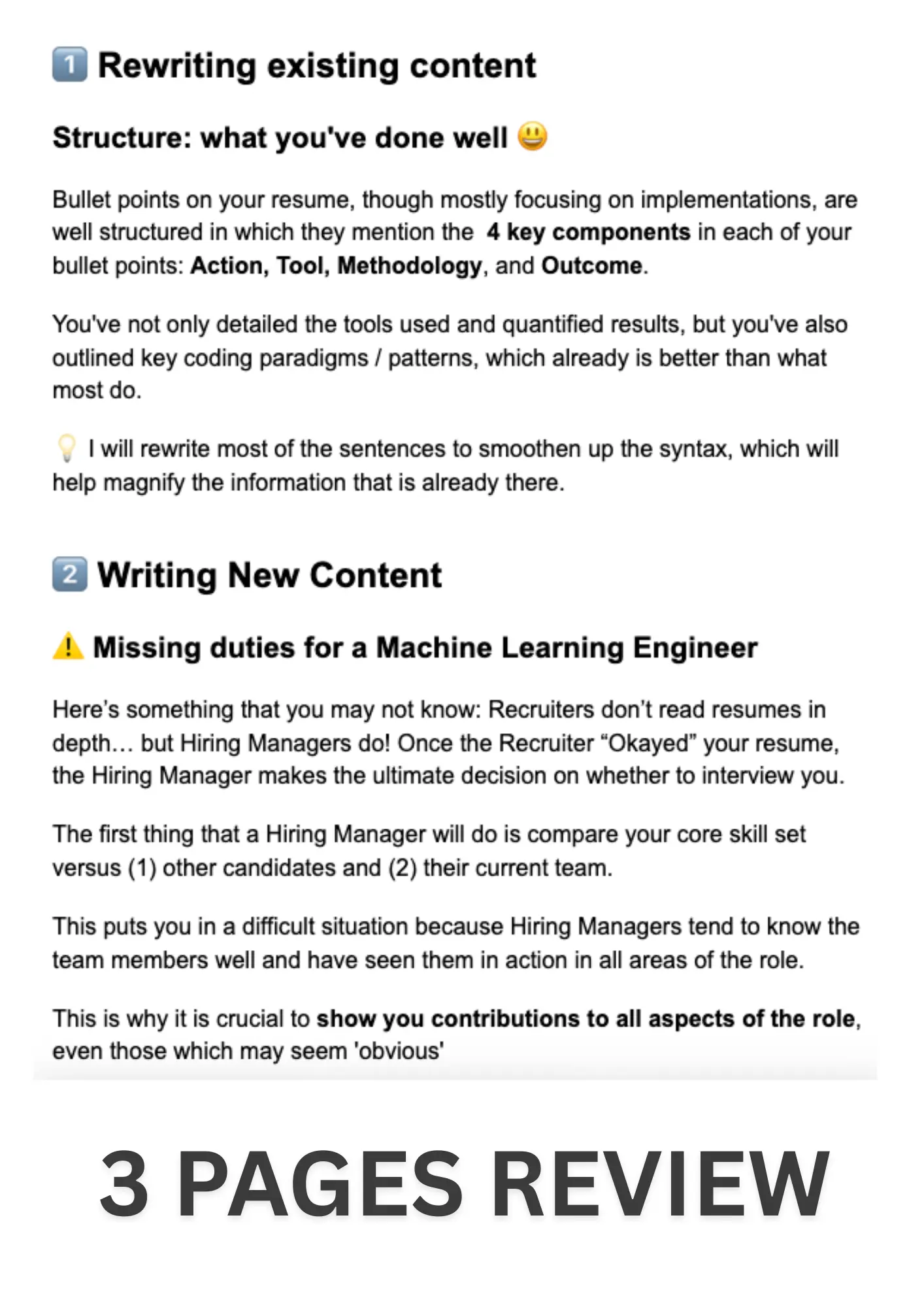What To Write About In Your Resume (A Step-By-Step guide to Role
Profiles)
If you are staring at a blank page or need to improve your resume,
this post should help.
For context, I'm a former Google Recruiter who runs a resume writing
service dedicated to IT & Software Engineering
I've worked with more than 1,000 clients, many of whom come to me
with common struggles and questions. I try to address each of these
with this blog, so that everyone can benefit from insider knowledge
for free.
In my last article on
How recruiters screen resumes, I explained that your CV is reviewed at least twice before a
decision to interview is made.
That article provided an overview of the hiring process and gave you
a checklist to optimize for the first filter (Initial Screen)
applied by recruiters.
You're probably curious about the rest of the process, so today
we'll cover the next logical step: how to get
shortlisted.
For your reference, here's a quick reminder of the different
screening phases within the hiring process:
| 🏁 Step |
🎯 Goal |
👔 Decision Maker |
🔍 Review Style |
⏱️ Time Spent |
|
1️⃣ Initial Screening (covered
here)
|
Filter relevant CVs |
Recruiter |
Fast |
5–20 seconds |
| 2️⃣ Shortlisting |
Select best resumes |
Recruiter + Hiring Manager |
Detailed |
1–5 minutes |
| 3️⃣ Interview Preparation |
Prepare detailed questions |
Hiring Manager |
In-depth |
5–10 minutes |
The "Shortlisting" review
In the previous post, I explained that your most recent position is
one of the 3 key pieces of information a recruiter seeks to make a
decision. Where the initial screen was just a rapid skim, this time
it will be read entirely, most likely by the recruiter
and the hiring manager.
At this point, it's critical for you to understand how this review
is performed. Reviewers are going to have a (more or less
formalized) list of
core competencies they want to see
appear within the description of your roles.
At that stage, most of the resumes under consideration are relevant,
so addressing most of these topics (core competencies) is critical
to score the extra points needed to stand out.
Here's the key takeaway:
Just writing down what you think matters isn't enough.
You need to prove that you can excel in all (or most) aspects of the
position.
So... how do you know what these core
competencies are? You need a
role profile!
What's a Role Profile?
"Role Profile" is an HR term used to define a position with a set of
duties, scope/complexity and seniority.
The more competitive an employer is, the more sophisticated that
definition is. For example, FAANG would have detailed internal
documentation to define and assess any role within their
organization.
These are not job descriptions! These role profiles also theorize
levels of autonomy, leadership, problem solving, and other
qualitative aspects.
These frameworks are used by recruiters to assess candidates and by
hiring managers to evaluate their team during performance reviews.
These criteria are very clear in their minds when your resume is
being screened.
This means that you need to get a good idea of the role profile for
your target position to write a competitive resume.
It’s an editorial exercise.
This may sound abstract, so we're going to use a real-life example.
Check out this next section for a
step-by-step guide!
Step 1 - Collect Job Descriptions
We need the data first and the best data you can find are job
descriptions.
You're probably thinking “I've read many of them already” ... but I
doubt you've ever analyzed them in detail and objectively. Job
descriptions are more insightful than you think, especially when you
know how to read between the lines.
In the
resume screen post, we used a Front-End Developer position as an example, so let’s
use that here too for simplicity.
📌 What we'll do:
You'll need to gather around
5 job descriptions for your target
roles.Your selected job descriptions need to be consistent in terms
of:
-
Job Title (example: Front-End
Developer)
-
Company Type (example: FinTech
startups)
- Seniority (example: Junior)
The more job descriptions you use, the better, but if your target is
clear, most of them will be similar, so adding more won’t help much
after a point.
For the sake of our example, we'll target a Front-End role at
FAANG/Big Tech companies, so we should gather job descriptions from
Meta, Amazon, Google, Microsoft and the like. I want to keep this
post simple so I'll only show you 2 of them, but you'll get the
gist.
Bear in mind that we'll need to analyze the entire job description
(not only the "requirements" part,
which is actually the least insightful).
For reference, here are the 2 job descriptions I've selected
📌 JD 1 - Front End Engineer, FinAuto @ Amazon
We’re searching for an engineering leader. You’ll write exemplary
code that makes it easy for the next person to do what’s right,
and impacts engineers well beyond your own team. You’ll use your
expertise to drive your team to deliver to your high standards.
You'll mentor peers, and help them become better engineers.
We collaborate across disciplines. You will have the opportunity
to work closely with product managers, UX designers, and
researchers and data engineers to innovate, measure, analyze and
refine the experiences we deliver to our users across the planet
on a daily basis. Our roles are all well defined, but we encourage
individuals to cross boundaries and learn from each other. If this
sounds like you and you are looking for a high morale team that
drives results that influence the experience of thousands of
finance users and millions of vendors and customers, this is the
right place for you.
・ 4+ years of non-internship professional front end, web or
mobile software development using JavaScript, HTML and CSS
experience
・ 5+ years of front-end developer creating prototypes or
wire-frames for enterprise web applications or workflows
experience
・ Experience developing with MVC/MVM frameworks (e.g. React.JS,
AngularJS, Vue)
Preferred Qualifications
・ Knowledge of web services technologies such as SOAP, HTTP,
WSDL, XSD, and REST
・ Experience in a broad range of software design approaches and
common UX patterns.
source:
Amazon Jobs
📌 JD 2 - Software Engineer, Front-End @ Meta
Responsibilities
・ Lead complex technical or product efforts involving many
engineers
・ Provide technical guidance and mentorship to peers
・ Implement the features and user interfaces of Facebook products
like News Feed
・ Architect efficient and reusable front-end systems that drive
complex web applications
・ Collaborate with Product Designers, Product Managers, and
Software Engineers to deliver compelling user-facing products
・ Identify and resolve performance and scalability issues
Minimum Qualifications
・ JavaScript experience, including concepts like asynchronous
programming, closures, types, and ES6
・ HTML/CSS experience, including concepts like layout,
specificity, cross browser compatibility, and accessibility.
・ Experience with browser APIs and optimizing front end
performance
・ Demonstrated experience driving change within an organization
and leading complex technical projects
Preferred Qualifications
・ Experience with React
・ Bachelor's degree in Computer Science, Computer Engineering,
relevant technical field, or equivalent practical experience.
source:
Meta Careers
Step 2 - List "Topics" & "Notions"
Next, we’re going to build a 2-column table with 2 headers named
"Topics" and
"Notions".
-
In the “Topic” column, we'll list the areas of contribution and
concepts included in the job description.
-
In “Notion”, we'll list any term related to a specific topic.
We'll put down the exact wording used in the job description.
-
For engineering roles, I like to separate technical and
non-technical topics to provide reviewers with more clarity, but
this is optional.
Analyzing JD 1 (Amazon)
Technical
| Topic |
Notions |
| UI/UX Design & Design Patterns |
“MVC/MVM”, “UX patterns”, “web or mobile” |
| Prototyping & Wireframing |
“creating prototypes or wire-frames” |
| Implementation with Front-End Technologies |
“JavaScript”, “React.JS, AngularJS, Vue”, “HTML”, “CSS” |
| Web Services |
“SOAP, HTTP, WSDL, XSD, and REST” |
| Testing & QA |
“measure, analyze”, “high standards”, “exemplary code” |
| Performance Optimization |
“refine the experiences” |
Non-Technical
| Topic |
Notions |
| UI/UX Design & Design Patterns |
“MVC/MVM”, “UX patterns”, “web or mobile” |
| Prototyping & Wireframing |
“creating prototypes or wire-frames” |
| Implementation with Front-End Technologies |
“JavaScript”, “React.JS, AngularJS, Vue”, “HTML”, “CSS” |
| Web Services |
“SOAP, HTTP, WSDL, XSD, and REST” |
| Testing & QA |
“measure, analyze”, “high standards”, “exemplary code” |
| Performance Optimization |
“refine the experiences” |
| Leadership & Mentorship |
“mentor peers”, “help them become better engineers”, “learn
from each other”
|
| Cross-functional Collaboration |
“collaborate across disciplines”, “work closely with product
managers, UX designers, and researchers and data engineers”,
“beyond your own team”
|
Step 3 - Structure your Job Block
Step 4 - Write bullet points
Bonus: Finished Job Block Example
Related Posts
How to write a Profile Summary
Write a high-impact Profile Summary that hooks recruiters
and
improves your conversion rate. This step-by-step guide breaks down the structure, common
mistakes, and proven techniques with real-world examples.
Posted on June 20, 2025
Read Article →
How to write amazing Bullet Points
Learn about the
Levels System: the framework
I developed to write amazing bullet points. Follow this
5 steps checklist to rank
your resume within the
top 1%.
Posted on June 20, 2025
Read Article →

